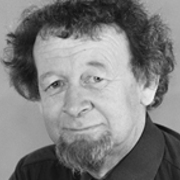
Brian Cross
At the age of 22 Brian Cross joined the National Film Unit as a camera trainee, learning his craft alongside experienced cameramen filming mostly in 35mm black and white. His first solo assignment appears to have been filming the tour of the visiting prime minister of Ceylon in November 1955. Taken for the government of Ceylon, the film was not released in New Zealand.
About the same time he filmed scenes of track-laying and ballasting, and of the final days of the Fell locomotives at Cross Creek, for New Wairarapa Railway (1955, released as Pictorial Parade No. 43). It was the first of many films about New Zealand’s railways to feature his camera work. Two years later he filmed The Changing Railways (1957, released as Pictorial Parade No. 65), further documenting the passing of the steam era.
Cross often worked as part of a team of cameramen covering royal visits by the Duke of Edinburgh and the Queen Mother, the tour of the British Lions Rugby team, and big events such as the opening of Wellington Airport. His first colour film was The Māori Today, filmed in early 1960, but not released until early 1961.
In June 1960 he flew to England to film the maiden voyage of HMNZS Otago, the first ship built for the Royal New Zealand Navy. While in England, between filming sea trials, refuelling exercises and mock battles, he was able to spend time studying television news production, hoping to fill a gap in expertise as New Zealand was beginning TV transmissions.
On the voyage to New Zealand he filmed shipboard life and the exotic ports of call. His twin roles as cameraman and director of A Ship Sails Home, went unacknowledged on screen, as the film was completed at a time when NFU films did not carry credits. His first on-screen credit was for colour tourist film Holiday for Susan (1962).
Other colour tourist films followed along with work on the black and white Pictorial Parades. Over a period of sixteen years he filmed or assisted with filming about 70 items on various subjects for this long-running NFU magazine-film series. His single-item reels for Pictorial Parade included films celebrating the centennial of New Zealand Railways in 1963 (Pictorial Parade No. 143 - Railways Centennial), the Denniston incline in 1967 (Pictorial Parade No. 195 - After Ninety Years), and steam power at work on the Midland Line in Pictorial Parade No. 200 - Kb Country (1968).
During 1964 and 1965 Cross filmed progress on the building of Benmore dam, and on the construction of the transmission line northward through the South Island and across Cook Strait to Haywards in the North Island. From this colour footage he directed two films, The First Half-Million Volt D.C. Transmission Line, an instructional film for the Electricity Department; and Inter-Island Power, a short documentary for general theatrical release. A few years later he filmed and directed a similar film The Line, covering the construction of the transmission line from Manapouri to Bluff.
He also filmed and directed The Young Giant Kaingaroa (1966), showing how the New Zealand Forest Service was managing one of the largest exotic forests in the world.
By the early 1970s most of his filming was being done in 35mm colour with theatrical release in mind. This was the case with the railways films The Ride of 480 (1971) and A Train for Christmas (1975), and a film that required periodic shooting over a lengthy period, Tahere Tikitiki - The Making of a Māori Canoe (1974). But until the introduction of colour television in late 1973, titles made for television were filmed on 16mm in black and white. Thursday’s Children (1972) and The Street (1973) were two such films Cross worked on.
In 1974, along with all the NFU camera personnel, he went to Christchurch to film the Xth British Commonwealth Games. Games 74, the NFU’s official feature film, made it to picture theatres so many months after the live colour telecasts that it was not a commercial success.
The new NFU studio complex in Lower Hutt was opened in October 1978, and Cross continued to work as a cameraman on many varied films; but now he worked alongside younger cameramen, passing on to them the benefit of his experience.
It was somewhat appropriate that his last film, made in the final days of the NFU, as it was being prepared for sale, was Steam on Parade (1989), celebrating a continuing affection for the steam locomotive.
Brian Cross died on 11 May 2004.
Writing and Original Research by Clive Sowry
Sources include
Photograph of Brian Cross courtesy of Archives New Zealand/Te Rua Mahara o te Kāwanatanga (Wellington office). Reference AAQT 6421 B18889
Brian Errol (Death Notice) – The Dominion Post, 12 May, 2004, Page D7
Anonymous, 'Lights, Camera . . .' – The Rotorua Post, 18 February 1960, Page 1
NFU Production file 3/8/95 A Ship Sails Home – H.M.N.Z.S. Otago. [Archives New Zealand reference: AAPG W3435 Box 37]